 History
History  History
History  Creepy
Creepy 10 More Representations of Death from Myth, Legend, and Folktale
 Technology
Technology 10 Scientific Breakthroughs of 2025 That’ll Change Everything
 Our World
Our World 10 Ways Icelandic Culture Makes Other Countries Look Boring
 Misconceptions
Misconceptions 10 Common Misconceptions About the Victorian Era
 Mysteries
Mysteries 10 Strange Unexplained Mysteries of 2025
 Miscellaneous
Miscellaneous 10 of History’s Most Bell-Ringing Finishing Moves
 History
History 10 Great Escapes That Ended Right Back in Captivity
 Weird Stuff
Weird Stuff 10 Fascinating Things You Might Not Know About Spiders
 Food
Food 10 Everyday Foods You Didn’t Know Were Invented by the U.S. Military
 History
History 10 Most Influential Protests in Modern History
 Creepy
Creepy 10 More Representations of Death from Myth, Legend, and Folktale
 Technology
Technology 10 Scientific Breakthroughs of 2025 That’ll Change Everything
Who's Behind Listverse?

Jamie Frater
Head Editor
Jamie founded Listverse due to an insatiable desire to share fascinating, obscure, and bizarre facts. He has been a guest speaker on numerous national radio and television stations and is a five time published author.
More About Us Our World
Our World 10 Ways Icelandic Culture Makes Other Countries Look Boring
 Misconceptions
Misconceptions 10 Common Misconceptions About the Victorian Era
 Mysteries
Mysteries 10 Strange Unexplained Mysteries of 2025
 Miscellaneous
Miscellaneous 10 of History’s Most Bell-Ringing Finishing Moves
 History
History 10 Great Escapes That Ended Right Back in Captivity
 Weird Stuff
Weird Stuff 10 Fascinating Things You Might Not Know About Spiders
 Food
Food 10 Everyday Foods You Didn’t Know Were Invented by the U.S. Military
Top 10 “Who Would Win” Battles That Played Out In Real Life
Ever wondered whether Japanese Samurai could beat Spanish Conquistadors? Or if the Roman Legion could fight an ancient Chinese army, or if an army of War Elephants would stand a chance against modern artillery?
Some of those “who would win” battles that we love to wonder about do not have to be imagined—they have played out in real life. Scattered throughout history, there are moments when fighters and armies that no one would ever have expected to meet, stared each other down across a battlefield. And only one side walked out alive.
10Japanese Samurai vs. Spanish Conquistadors
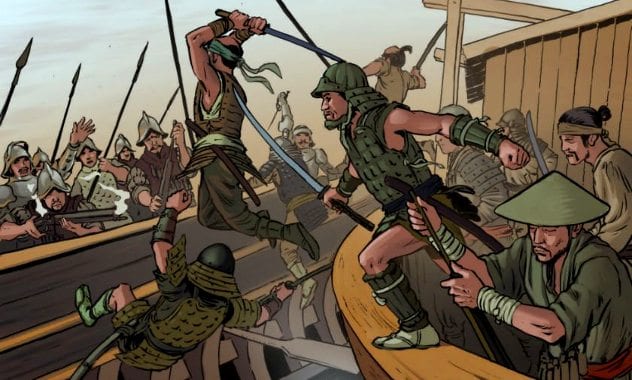
In 1582, a group of Spanish Conquistadors found themselves face to face with a band of armored, katana-wielding Ronin Samurai.
The Spaniards had been trading in the Philippines when Japanese pirates started raiding the countryside. Determined to protect their trade partners, 40 Spanish men moved out against the Japanese pirates. They spotted an incoming ship, engaged it in battle, and boarded the ship —and there, they found a group of Samurai waiting for them.
The Samurai wielded katanas, backed by Japanese pirates carrying muskets. The Conquistadors had pikemen, backed by Spanish Musketeers. For the first time in history, European pikes clashed with Japanese steel.
Winner: Decisive Spanish Victory
The Samurai did not stand a chance. The Conquistadors had stronger armor that they could not penetrate, and the Musketeers backing them up were better shots, with more reliable weapons. Not only did they beat the Samurai, but the 40 men went on to fight off a fleet of ten Japanese ships commanding thousands of men.
When it ended, the Spanish leader, Juan Pablo de Carrion, threatened to bring over 600 more men if the Japanese did not leave the Filipinos alone. The Japanese, without firing another shot, ran for their lives and stayed as far away from the Philippines as they could.
9War Elephants vs. Artillery
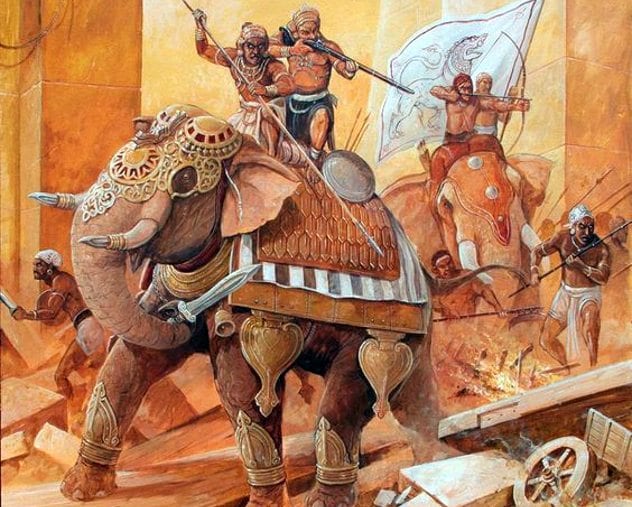
In 1825, a desperate Burmese commander, struggling against the encroach of the British Empire, sent out his best hope against the British artillery: an army of war elephants.
The Burmese commander, Maha Bandula, had just managed to repel a British attack against his base in Danubyu. He had won a rare chance to turn the tide in a war against an army with superior technology, and he took it. Bandula launched a counter-attack, led by his best soldiers, his cavalry, and 17 battle-trained elephants.
In ancient times, it would have been an unstoppable force—but now they were fighting against an army with guns and artillery, in an ultimate battle of the old world against the new.
Winner: Decisive Artillery Victory
The war elephants did not even make it to the enemy lines. As soon as they came close, the Burmese forces were blown away by a hail of rockets and shells. The elephants died before they could do any damage at all, and the cavalry could not even make it into range.
After the battle, the British attacked again and, this time, Bandula and his men had to evacuate. The Burmese fought as hard and as long as they could, but war elephants were simply no match for British artillery.
8Viking Raiders vs. Native American Warriors
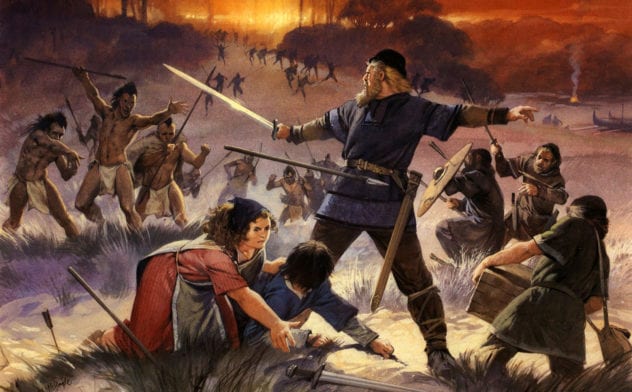
When the first Vikings landed in the New World, in the tenth century A.D., they came face-to-face with a native tribe. It did not go well. The two sides scuffled and argued and, in short time, the world saw all-out battles between Vikings and Native Americans.
Thorvald, the son of Erik the Red, got into fights with the locals in Newfoundland, who were likely Inuit. One argument went sour, and Thorvald ended up kidnapping and killing eight people. After that, the Vikings were clear enemies—and Native Americans became determined to chase them off.
Winner: Eventual Native American Victory
One-on-one, a Native American Warrior probably would have lost to a Viking, but they were a bit smarter about it. They chased away Thorvald by taking a hide-covered boat down a fjord, launching a volley of arrows at the Vikings, and then paddling away before they could strike back. The Vikings tried to take cover, but one of the arrows got Thorvald and killed him.
After Thorvald died, the Native Americans managed to chase away the Vikings altogether. They built a catapult and put a Viking town under siege, killing two of the Vikings within and chasing the rest away. Under the threat of constant harassment from Native Americans, the Vikings, in time, gave up and left the New World behind.
7Shaolin Monks vs. Pirates
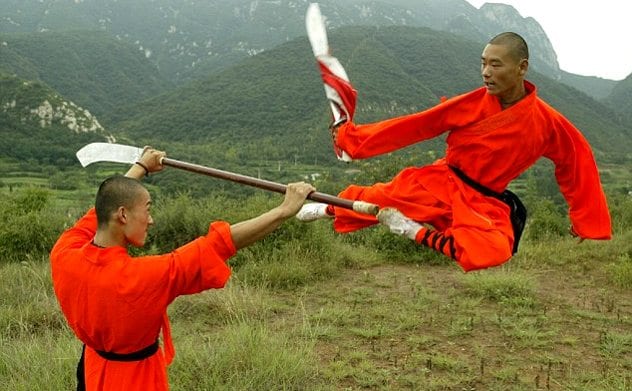
In 1550, a motley crew of Portuguese, Chinese, and Japanese pirates, using Western weapons, found themselves against an unlikely opponent. A group of Shaolin Warrior Monks had stepped down from their monastery—and they were ready to pit their Kung Fu against the pirate’s guns.
The pirates had been ravaging the Ming kingdom for years and, desperate, the Emperor called on a 1000-year-old Shaolin Monastery for help. The monks there were unparalleled masters of Kung-Fu, but they usually fought with staffs, while the pirates had advanced Portuguese guns and cannons. It was a battle of training against technology—whether sheer devotion to martial arts could overpower European weapons.
Winner: Decisive Shaolin Monk Victory
The monks fought the pirates in four battles and won three of them—but the best example is the Battle of Wengjiangag. There, 120 monks faced against 120 pirates—and the monks slaughtered their enemies. The pirates only managed to kill four monks before they were run down and massacred. Nearly every single one of the 120 pirates died, often beaten to death with iron staffs.
6Tiger vs. Lion

The ultimate battle for the King of the Jungle has been fought more than once. In nature, tigers and lions will usually leave each other alone—but pitted before an audience, that can change. Both the Romans and the Indians have had the big cats of the jungle fight before the eyes of a roaring crowd.
The Romans did it first, in the first century A.D., and the Indians copied them in the 19th century. In India, the fight was arranged by the Gaekwad of Baroda, who was so sure that the lion would win that he put down a 37,000 rupee bet.
Winner: Decisive Tiger Victory
Both times, the tiger won—and not even by a small margin. A witness to the Roman fight said, that not only did the tiger kill the lion, but she ripped it to shreds. And, in India, the Gaekwad of Baroda had to pay up his 37,000 rupee bet.
In nature, though, the animals would not have fought. The tiger “attempted nothing of the sort while she lived in the depths of the forest,” the Roman poet Martial wrote after watching the fight, “but since she had been among us, she has acquired great ferocity.”
5The Mongolian Horde vs. European Knights
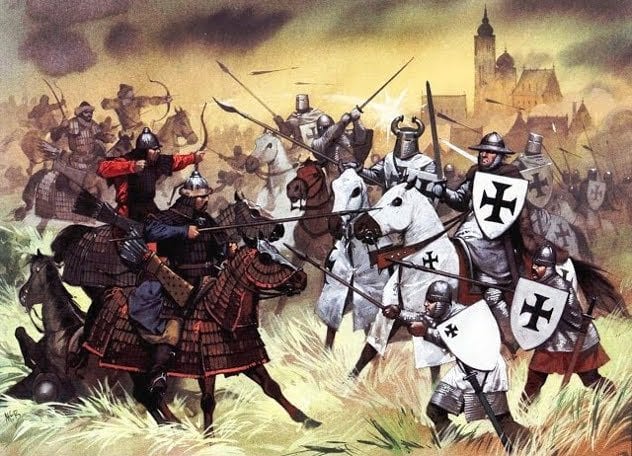
After the Mongolian Horde had swept through Asia, laying every person who stood in their way into the dust, they did not stop fighting. They pressed on into Europe—and there, went head-to-head with armored European Knights.
The Mongolians fought a whole war against the Europeans, but we will focus on the Battle of Liegnitz in 1241. Here, 70,000 Mongolian warriors, under the command of the grandson of Genghis Khan, brought their army against the Kingdom of Poland and the Knights Templar. Polish knights with lances and broadswords went head-to-head with Mongolian horsemen and their bows and arrows.
Winner: Decisive Mongolian Victory
The Europeans were not ready for Mongolian tactics. The Mongolian horsemen would feign attacks and fake withdrawals, slowly draining their enemies with a barrage of arrows while keeping a safe distance from their swords. The Knights, who were used to just charging and battering whoever was closest, did not know how to deal with it.
The Mongolians had killed 25,000 people before the battle was over. They managed to fill nine sacks full of ears torn off their enemies, and they cut the Polish Duke’s head off and paraded it around on the tip of a spear.
4Warrior Monks vs. Samurai
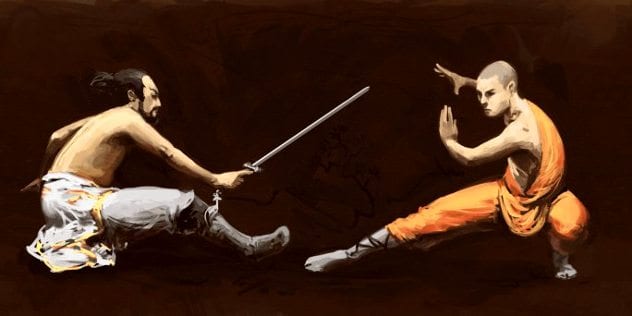
In 1180, the Japanese Prince Mochihito, after a failed attempt to steal the throne, hid out in a Buddhist temple. An army of samurai warriors was after him, and he had only one hope to stave them off: the temple’s warrior monks.
The samurai charged the temple and attacked, and the monks had to fight them off. These monks were not just using staffs—they had bows, swords, and daggers, but they were up against a whole army of armored samurai.
Winner: Short-Lived Warrior Monk Victory
The Warrior Monks managed to hold them off—and the stories left behind about their victory are so incredible that it is hard to separate fact from fiction. Legend has it that one of the monks stopped an incoming arrow by slicing it in half in mid-air, while another single-handedly killed 26 samurai.
Their victory, though, did not last. Even if they held off the first attack, the samurai came back—and this time they brought 10,000 soldiers with them. The monks did not stand a chance against that many people. The monastery was captured and burned to the ground, and Prince Mochihito was killed.
3Roman Legionnaires vs. The Chinese Army
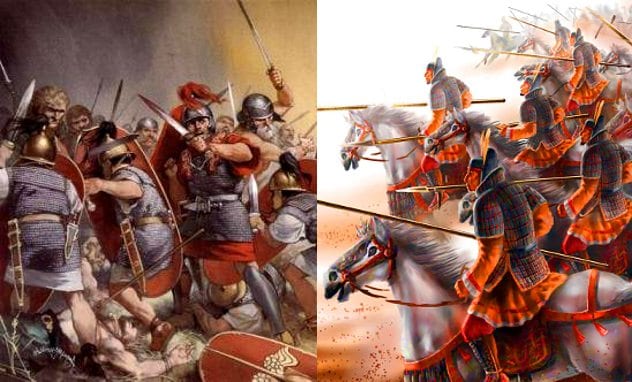
In 36 B.C., a Roman legion went missing. There is some dispute about what actually happened to them, but according to one theory, they went out east and ended up finding themselves amongst the Mongolian Huns. They thought they had found refuge. Soon, though, the Chinese Han army was at their gates—and, for the first time in history, Roman soldiers were face-to-face with Chinese warriors.
The Chinese soldiers would have had an infantry and a cavalry, trained in the Chinese art of deception and war—but the Roman legion had its shields. Chinese witnesses record seeing 145 foreign soldiers holding their long, rectangular shields close in an impenetrable tortoise formation.
Winner: Technical Chinese Victory
The Han Chinese won—but it was not really a fair fight. There were only 145 Romans there, and though they were backed by the Mongolian army, the Chinese had them drastically outnumbered. The Roman fighters, though, held their own well enough to make an incredible impression on the Chinese. When the battle was over, the Han Chinese enlisted every surviving legionnaire into the Han army.
2Viking Raiders vs. The Islamic Caliphate
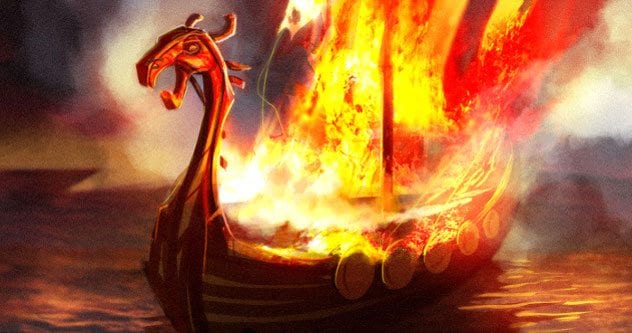
Viking raiders wreaked hell upon Europe—but in 844, their attacks made it far enough south to come face-to-face with another type of enemy: the Islamic Umayyad Emirate.
Islam, at this time, was spreading across the world, and a huge part of modern Portugal and Spain were ruled by an Islamic dynasty. They were led by the Syrian Abd al-Rahman, who first got word that Vikings were coming when his men spotted nearly 100 Viking ships off the coast of Lisbon. Viking raiders were coming—and, for the first time, they were against the armies of Muhammad.
Winner: Eventual Islamic Victory
The Islamic fighters won—eventually. Early on, though, it did not go particularly well. The Vikings crushed Lisbon and burned much of it to the ground. Then, for a month, they rampaged their way through Portugal, slaughtering the men and forcing the women and children into slavery.
The tide of battle turned, though, when the Islamic Army started using war engines. Once reinforcements and equipment came from their capital, Corboda, they actually stood a chance. They got vengeful. They took no prisoners. They burned the Viking ships and everything they owned, and every Viking they could get their hands on was killed.
1A Roman Emperor vs. A Killer Whale

Okay, this fight probably never occurred to anybody—but it happened. In the writings of the Roman philosopher Pliny the Elder, he records seeing something incredible: “A killer whale was actually seen in the harbor of Ostia, locked in combat with the emperor Claudius.”
A ship had capsized and filled the harbor with leather hides. The leather lured in a hungry whale, who got stuck in the shallows and caused havoc by splashing about. Claudius decided that this was an opportunity for one hell of a show—so he invited the whole Roman public to watch him fight a whale.
Winner: Technical Roman Victory
Claudius did not play fair, of course. He brought out a whole crew of ships and surrounded the whale to ensure he did not end up getting killed by an animal in front of the crowd. Even then, the Romans did a lot worse than you would expect.
The cornered whale blew water out of its spout and overturned a boat, sinking it and everyone on board. After that, every Roman on every boat just started hurtling lances and spears at it. They killed the whale, but it was hardly the one-on-one fight the public was promised—and, if you are counting casualties, the whale won.







![10 Real Countries Straight Out Of The Handmaid's Tale [DISTURBING] 10 Real Countries Straight Out Of The Handmaid's Tale [DISTURBING]](https://listverse.com/wp-content/uploads/2019/11/offredandafghan-150x150.jpg)
